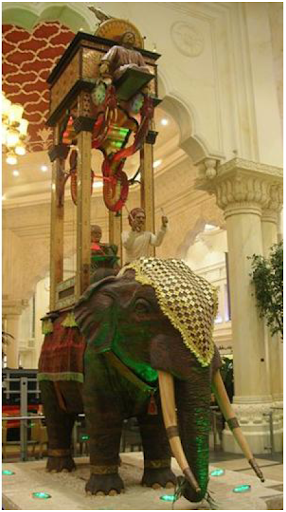Uni blog
A blog about the progress of my current project at University. Critique is encouraged.
Wednesday 10 November 2010
Basic Flash User Interface
Monday 8 November 2010
Researching how the book will look
The Automata Chosen + Presentation
The two easier ones are the:

The third one that will be much harder to model is:

The elephant clock does have a real world re-production I can use a reference:
Tuesday 2 November 2010
More reference found
Muslim Heritage
Automation Robotics In Muslim Heritage
I have also with help from the University's library managed to locate a borrowable copy of the translated book which will help vastly with this project.
Sunday 31 October 2010
Techniques and materials
Surprisingly medivil islam had quite a high level of technology for that time meaning thay had the resources to produce steel and cast iron.
(From Wikipedia)
"Iron technology was further advanced by several inventions in medieval Islam, during the so-called Islamic Golden Age. These included a variety of water-powered and wind-poweredmills for metal production, including geared gristmills and forges. By the 11th century, every province throughout the Muslim world had these industrial mills in operation, from Islamic Spain and North Africa in the west to the Middle East and Central Asia in the east. There are also 10th-century references to cast iron, as well as archeological evidence of blast furnacesAyyubid and Mamluk empires from the 11th century, thus suggesting a diffusion of Chinese metal technology to the Islamic world. industrial being used in the
Geared gristmills were invented by Muslim engineers, and were used for crushing metallic ores before extraction. Gristmills in the Islamic world were often made from both watermills and windmills. In order to adapt water wheels for gristmilling purposes, cams were used for raising and releasing trip hammers to fall on a material. The first forge to be driven by a hydropowered water mill rather than manual labour was invented in the 12th century Islamic Spain.
One of the most famous steels produced in the medieval Near East was Damascus steel used for swordmaking, and mostly produced in Damascus, Syria, in the period from 900 to 1750. This was produced using the crucible steel method, based on the earlier Indian wootz steel. This process was adopted in the Middle East using locally produced steels. The exact process remains unknown, but allowed carbides to precipitate out as micro particles arranged in sheets or bands within the body of a blade. The carbides are far harder than the surrounding low carbon steel, allowing the swordsmith to make an edge which would cut hard materials with the precipitated carbides, while the bands of softer steel allowed the sword as a whole to remain tough and flexible. A team of researchers based at the Technical University of Dresden that uses x-rayselectron microscopy to examine Damascus steel discovered the presence of cementitenanowires and carbon nanotubes. Peter Paufler, a member of the Dresden team, says that these nanostructures give Damascus steel its distinctive properties and are a result of the forgingBelow are the methods Al-Jazari used to creat his ideas.
(From Wikipedia)
"Camshaft
The camshaft, a shaft to which cams are attached, was first introduced in 1206 by Al-Jazari, who employed them in his automata, water clocks (such as the candle clock) and water-raising machines. The cam and camshaft later appeared in European mechanisms from the 14th century.
Crankshaft and crank-slider mechanism
The eccentrically mounted handle of the rotary handmill in 5th century BC Spain that spread across the Roman Empire constitutes a crank. The earliest evidence of a crank and connecting rod mechanism dates to the 3rd century AD Hierapolis sawmill in the Roman Empire. The crank also appears in the mid-9th century in several of the hydraulic devices described by the Banū Mūsā brothers in their Book of Ingenious Devices.
In 1206, Al-Jazari invented an early crankshaft, which he incorporated with a crank-connecting rod mechanism in his twin-cylinder pump. Like the modern crankshaft, Al-Jazari's mechanism consisted of a wheel setting several crank pins into motion, with the wheel's motion being circular and the pins moving back-and-forth in a straight line. The crankshaft described by Al-Jazarirotary motion into a linear reciprocating motion, and is central to modern machinery such as the steam engine, internal combustion engine and automatic controls. transforms continuous
He used the crankshaft with a connecting rod in two of his water-raising machines: the crank-driven saqiya chain pump and the double-action reciprocating piston suction pump. His water pump also employed the first known crank-slider mechanism.
Design and construction methods
English techonology historian Donald Routledge Hill writes:
We see for the first time in al-Jazari's work several concepts important for both design and construction: the lamination of timber to minimize warping, the static balancing of wheels, the use of wooden templates (a kind of pattern), the use of paper models to establish designs, the calibration of orifices, the grinding of the seats and plugs of valves together with emery powder to obtain a watertight fit, and the castingmold boxes with sand. of metals in closed
Escapement mechanism in a rotating wheel
Al-Jazari invented a method for controlling the speed of rotation of a wheel using an escapement mechanism.
Mechanical controls
According to Donald Routledge Hill, al-Jazari described several early mechanical controls, including "a large metal door, a combination lock and a lock with four bolts."
Segmental gear
A segmental gear is "a piece for receiving or communicating reciprocating motion from or to a cogwheel, consisting of a sector of a circular gear, or ring, having cogs on the periphery, or face."Lynn Townsend White, Jr. wrote: Professor
Segmental gears first clearly appear in Al-Jazari, in the West they emerge in Giovanni de Dondi's astronomical clock finished in 1364, and only with the great Sienese engineer Francesco di Giorgio (1501) did they enter the general vocabulary of European machine design."







